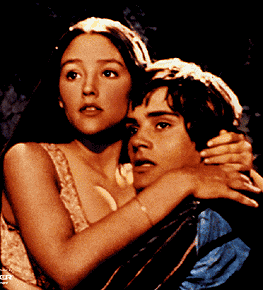 |
| Romeo and Juliet in the Orchard |
Romeo seems to be saying that Juliet is the only ray of morning light that ends the long darkness of night. Figurative language such as this helps the readers to visualize what is physically happening if they are not watching the play be performed. When Romeo says that Juliet is "like the sun" the reader can imagine that she is glowing, or is radiant in Romeo's mind. This aids reader enjoyment because they are able to connect a visual to the information they are taking in on paper in a way that makes the story feel more real.
 |
| The Two Lovers Worried About Being Found |
In the first line of this quote Romeo describes Love as if it was an object that could have human features. This is the most common form of personification, when an idea or inanimate thing is described doing something human. For example you could come across something such as "the wind slapped me in the face" meaning the wind blew strongly on them, not that it physically reached out and slapped them with an arm because it has no arms. This is the most common and most widely known form of personification.
But the other use is also there within the quote, this second use is when an author talks about an idea, or something intangible, as if it is an object or person. In the case of the quote above, the last three references to Love use this other form of personification. Romeo talks about walls being unable to keep love out as if it was a person that was trying to get through the walls. But as a reader you know that the Love itself is not the one doing the acting, but Romeo is and he is, therefore, indirectly talking about himself whenever he talks about Love.
Personification is a good way to add understanding to the play because it helps to show what emotions make characters do different tasks and how objects or ideas affect the characters in the play. In most cases it helps to add detail in a more interesting manner than if the author just came right out and told you the detail. A good example of this is in some simple personification from Friar Lawrence, "The gray-eyed morn smiles on the frowning night" (II.iii.1,). Now this essentially means that the night was a gloomy one and the new morning, which is just beginning, is calm and happy. Sure this isn't an easy way to say that but it is much more poetic and interesting than if Shakespeare had decided to say: "This morning is calmer and nicer than the gloomy night we just had." Wouldn't you much rather read the first line than the second? This is when personification comes in handy; sure the morning doesn't have eyes, and they certainly aren't gray, but this way of describing it is more enjoyable and it still makes sense.
There are many different kinds of figurative language, I have only talked about a couple. They do all sorts of things from comparing objects that would never be alike to providing a visual so well described it appears before your eyes, and they're everywhere within literature. The types I talked about also aren't the only ones in Shakespeare's Romeo and Juliet. Take some time to watch the video below and see how many forms of figurative language you can find within the excerpt of the balcony scene. There are definitely a few more in there, so take some time and see what other ones you recognize. Feel free to refer to the website from the first paragraph, it has a list of some different kinds of figurative language with definitions.
Works Cited:
Domblewski, Carol. "The Tragedy of Romeo and Juliet." Prentice Hall Literature: Timeless Voices, Timeless Themes. Upper Saddle River, NJ: Prentice Hall, 1999. N. pag. Print.
No comments:
Post a Comment